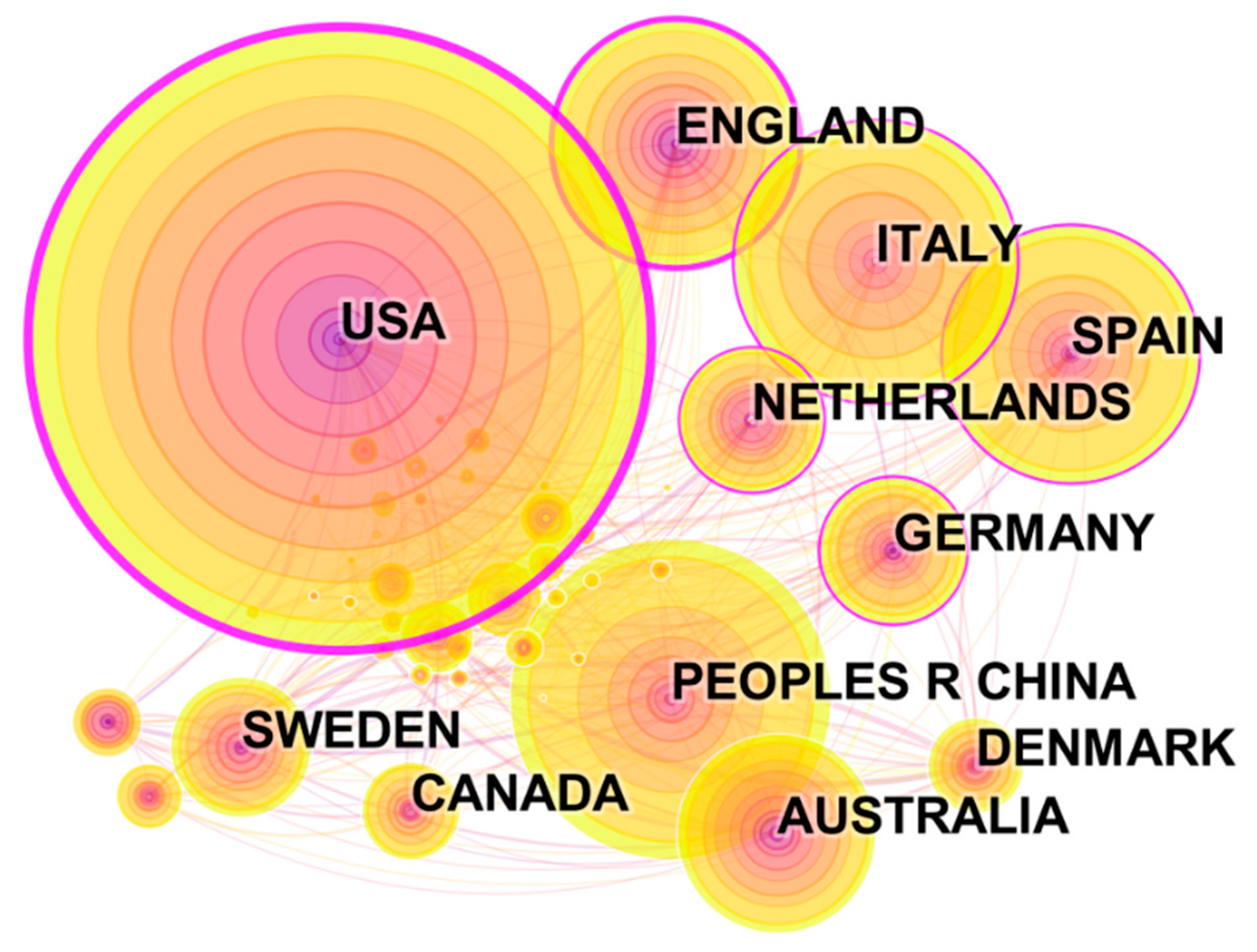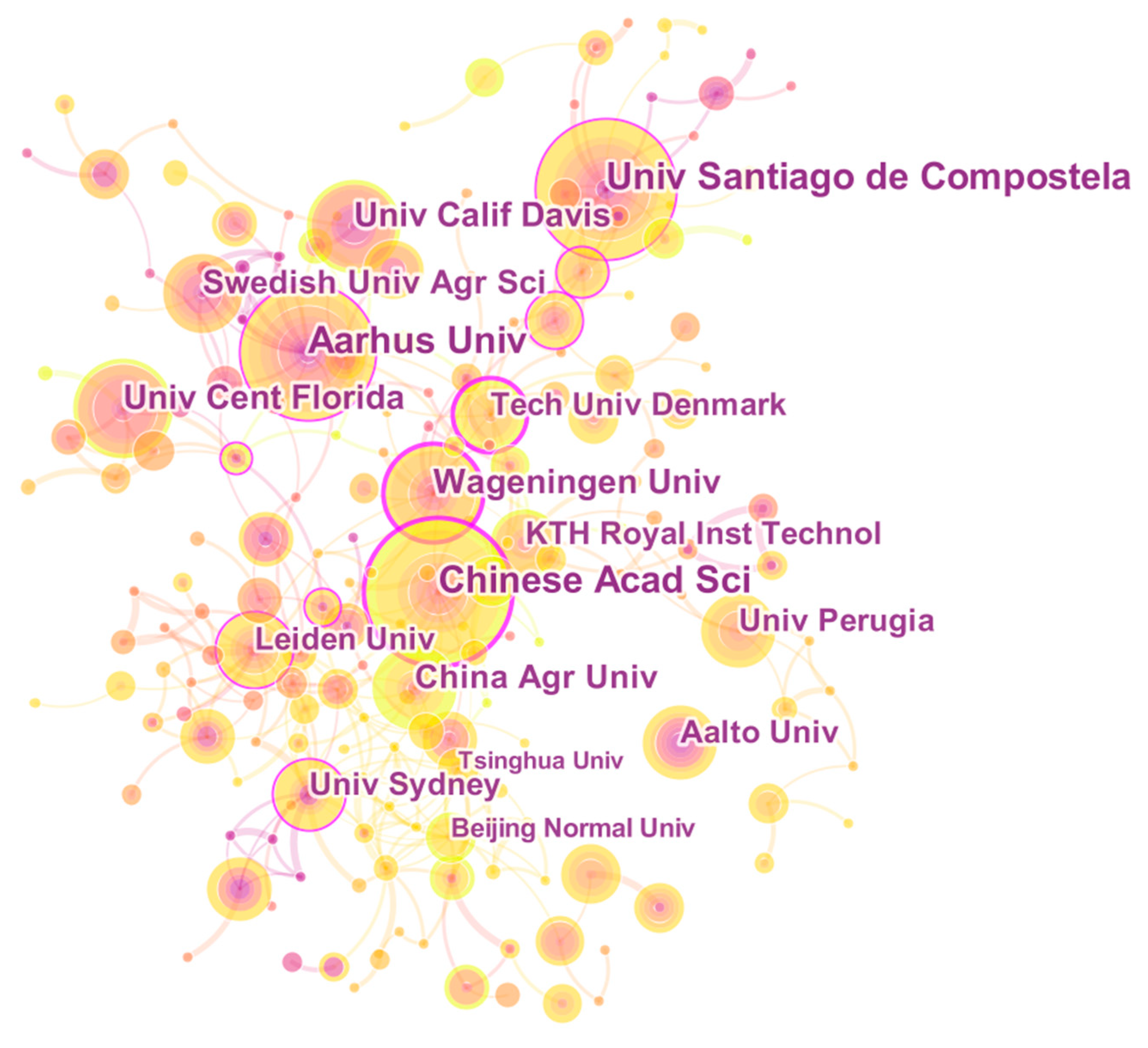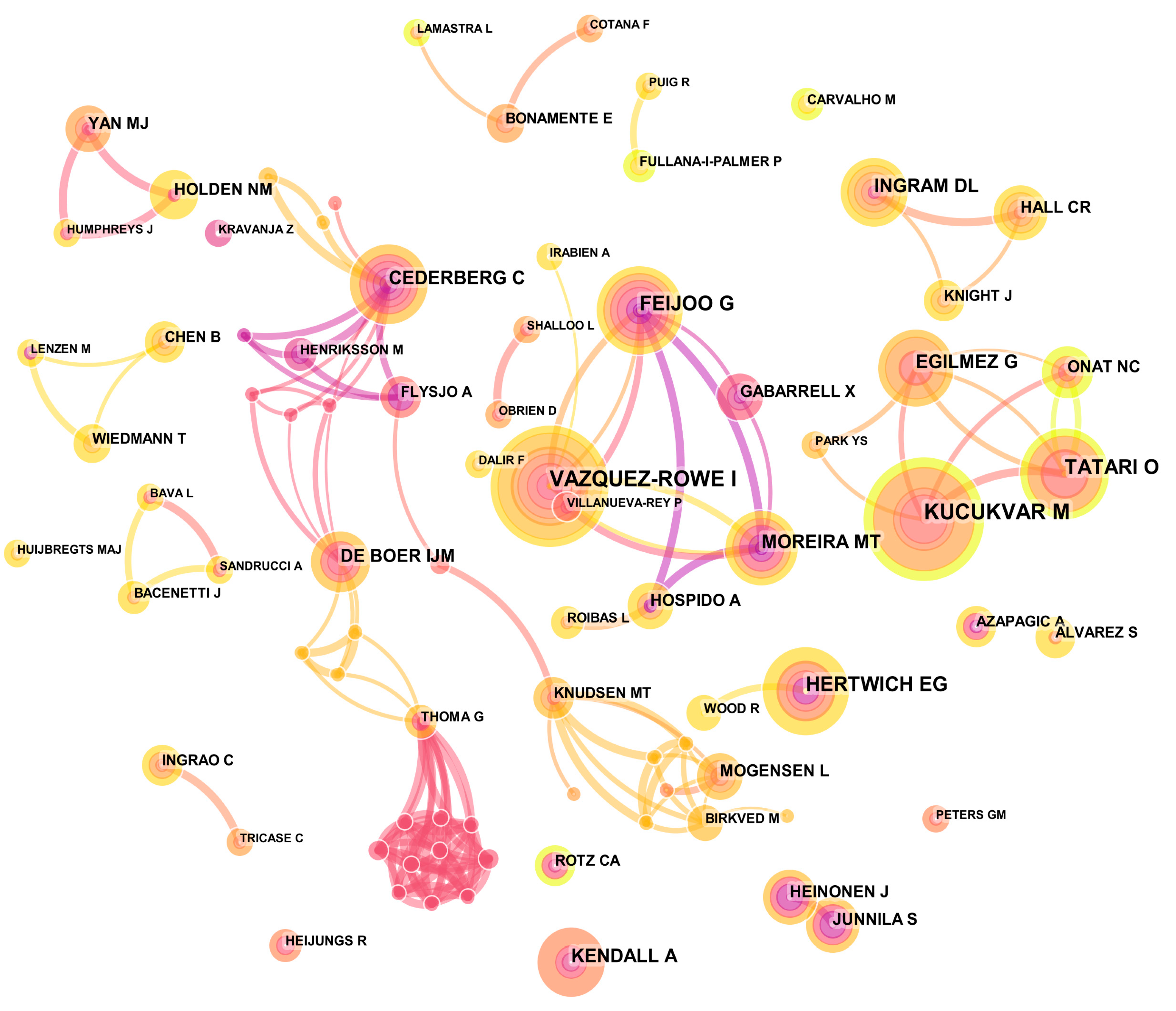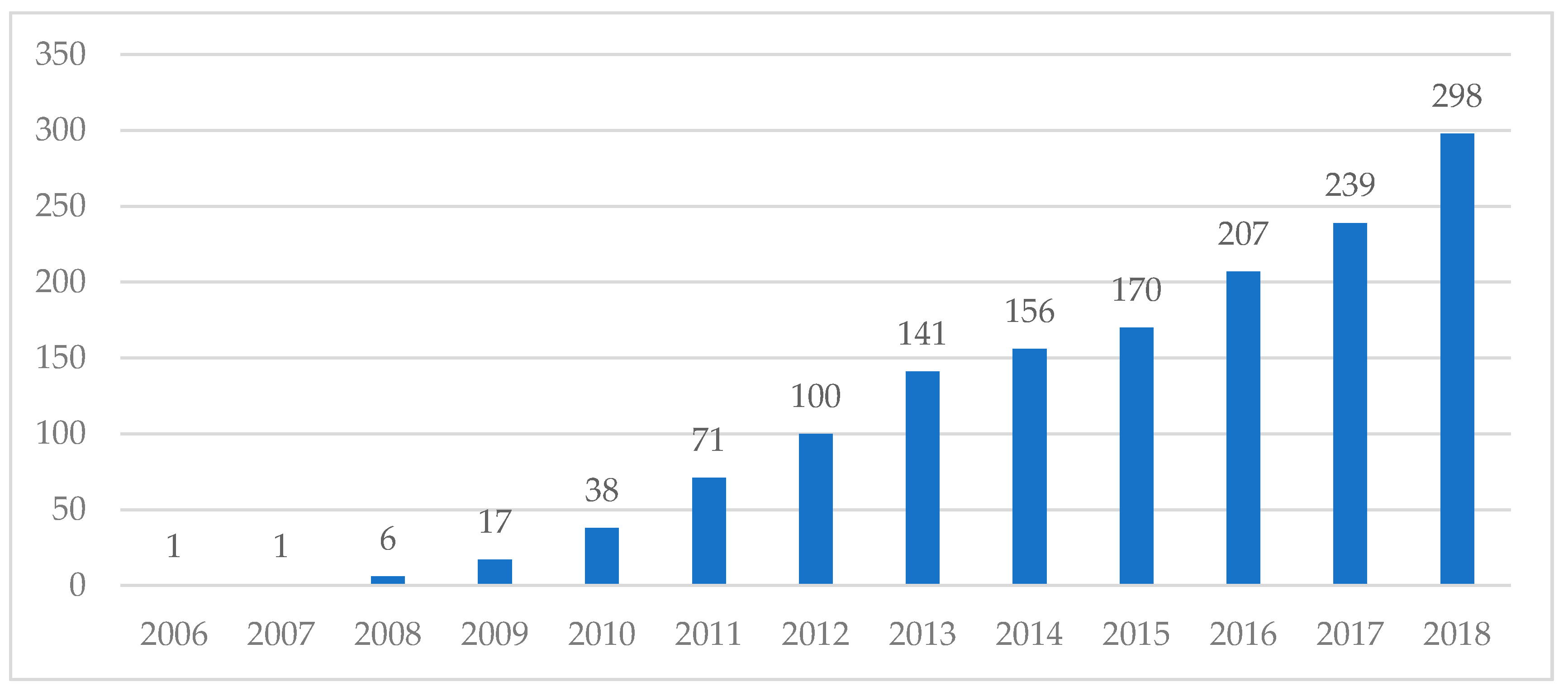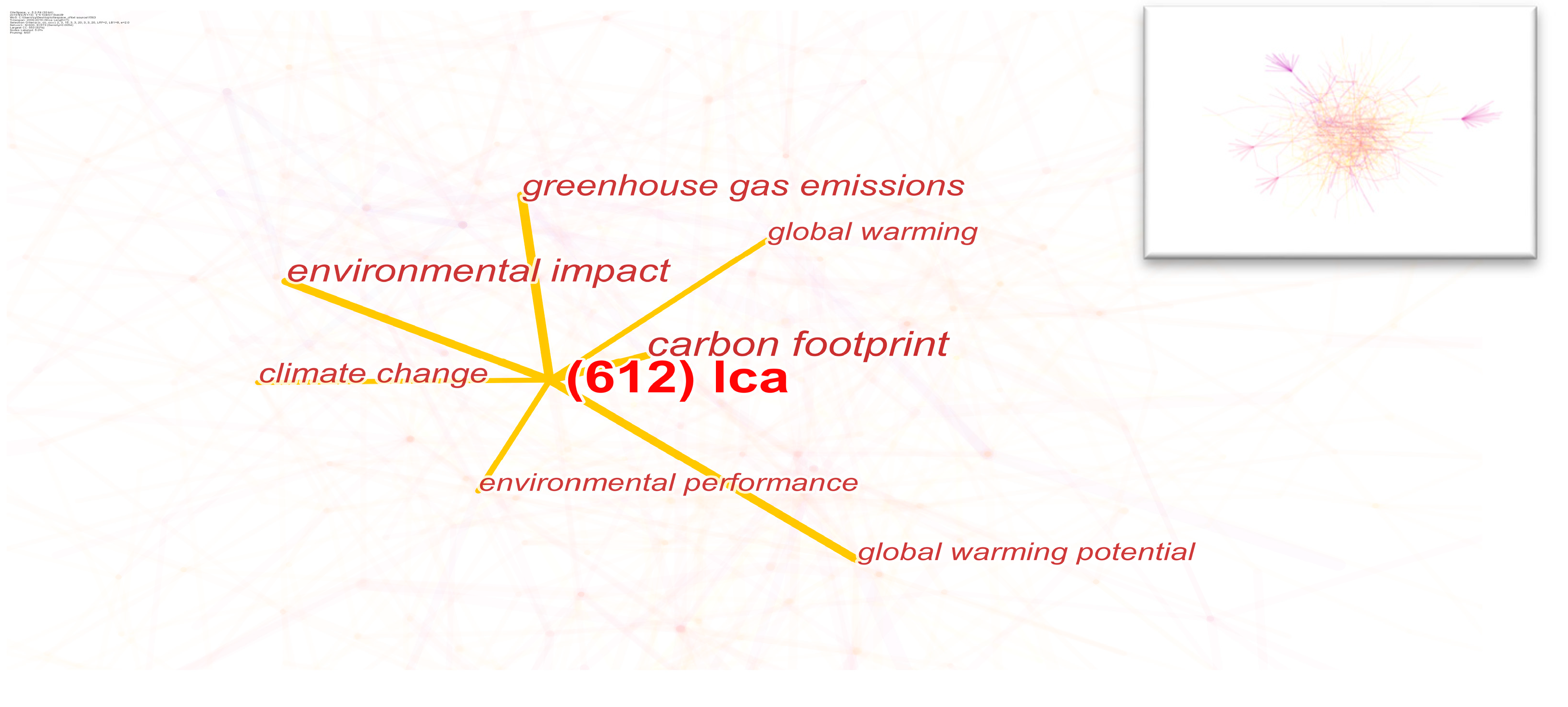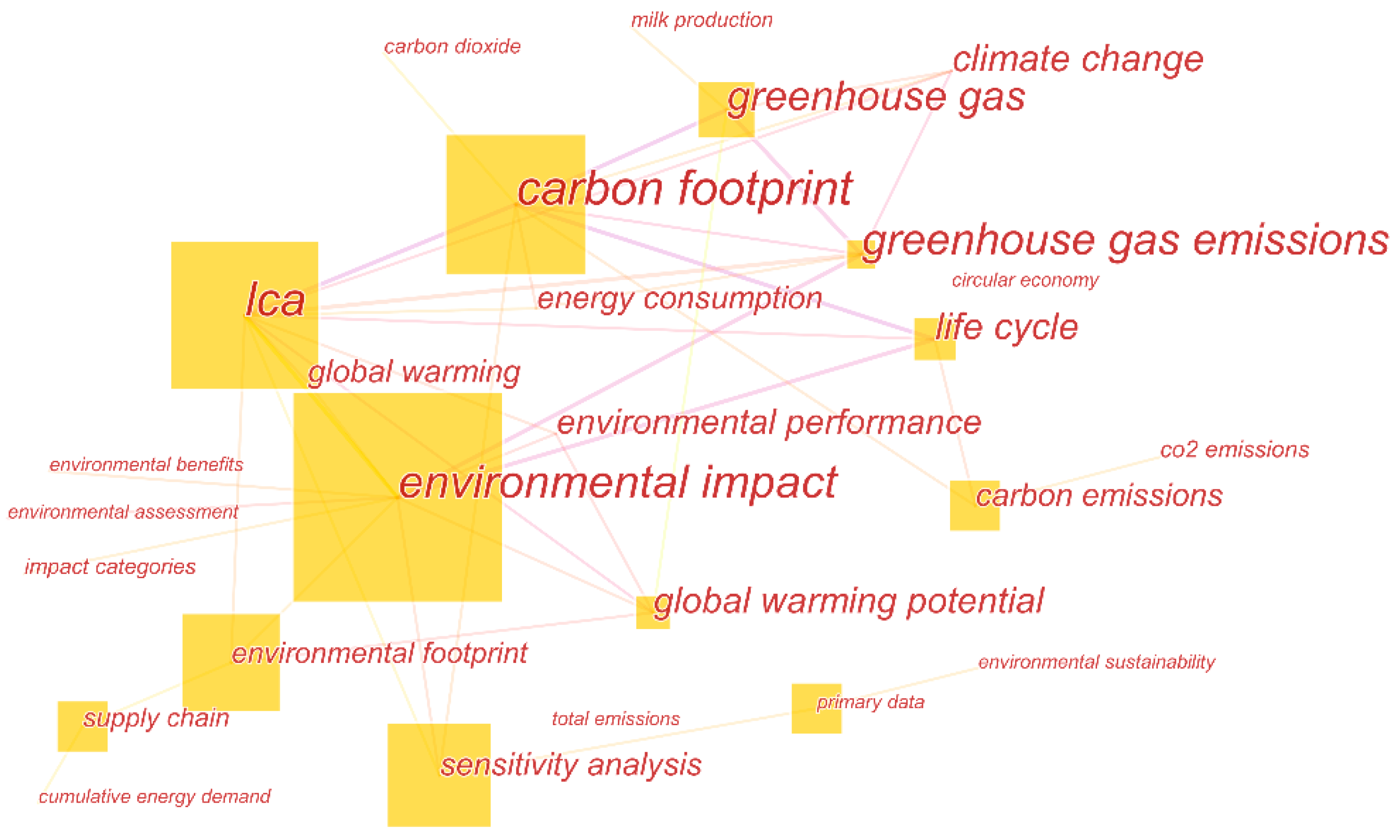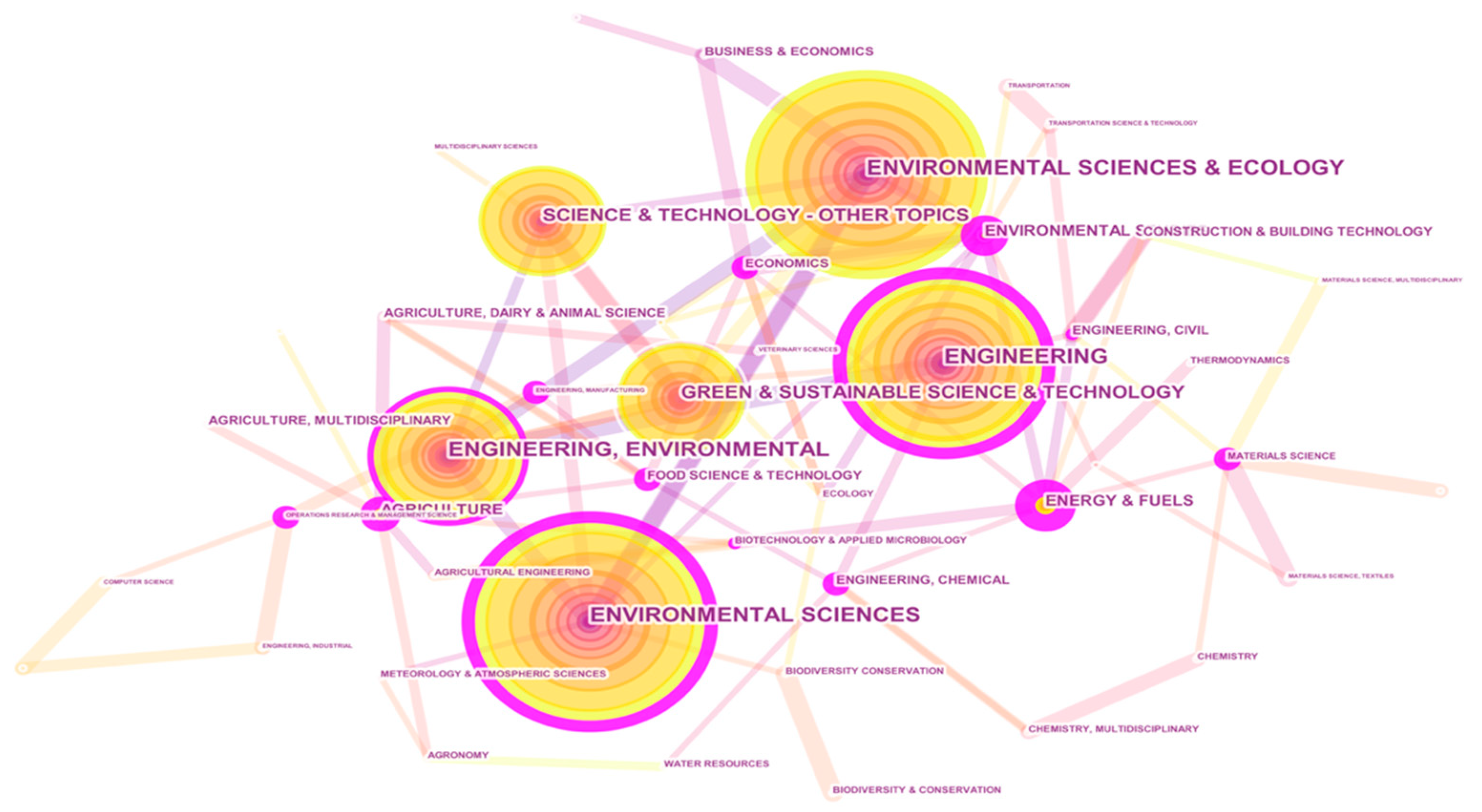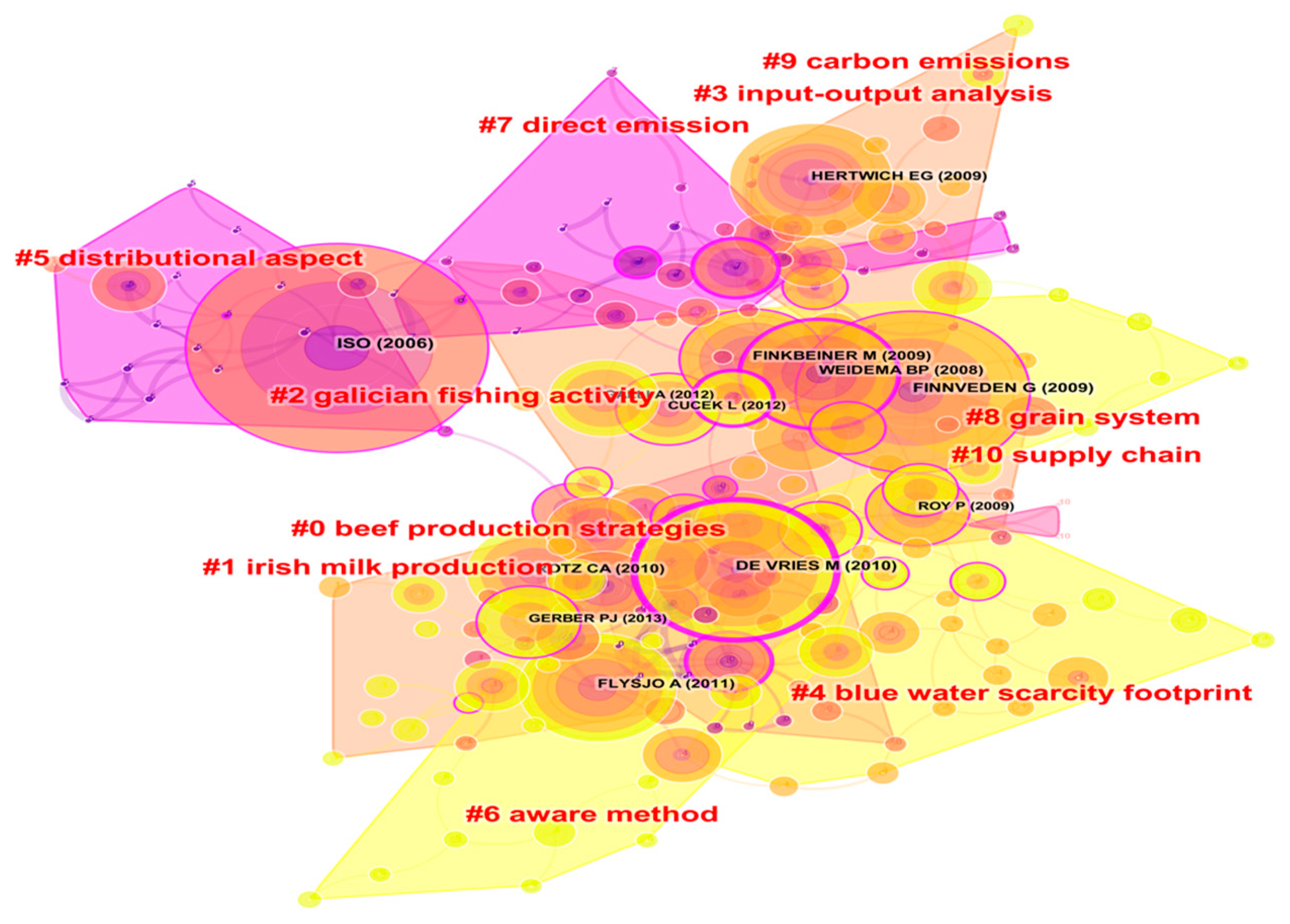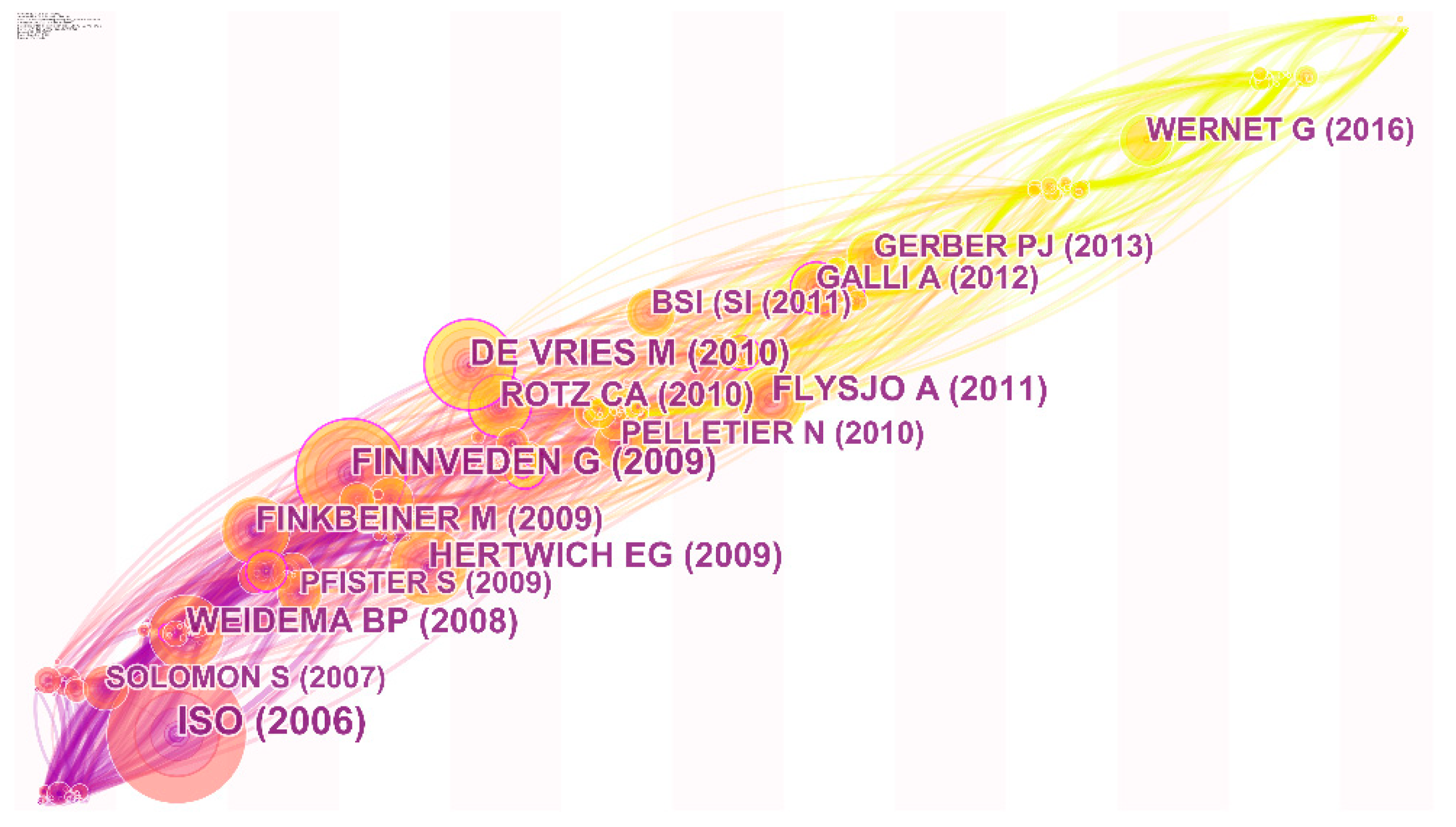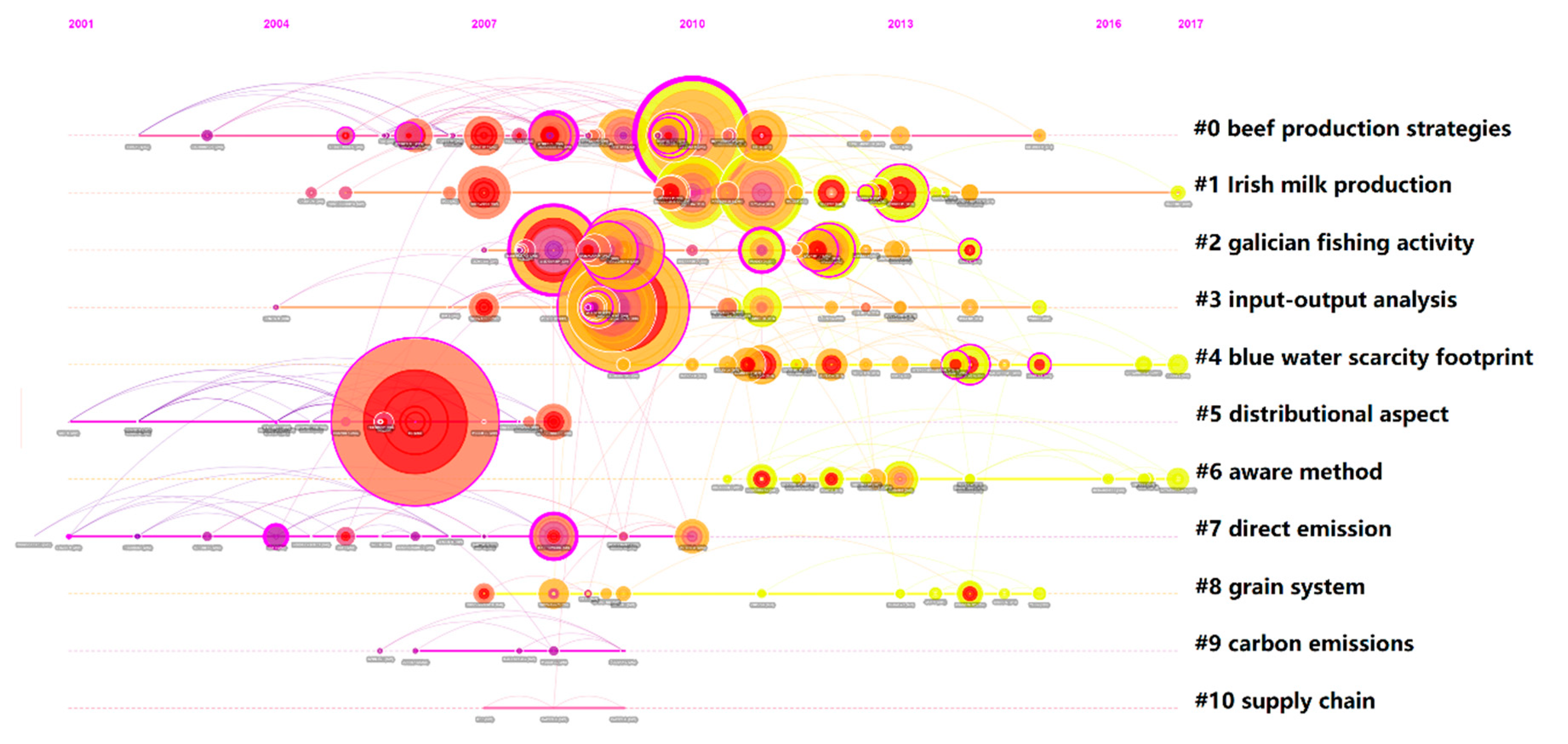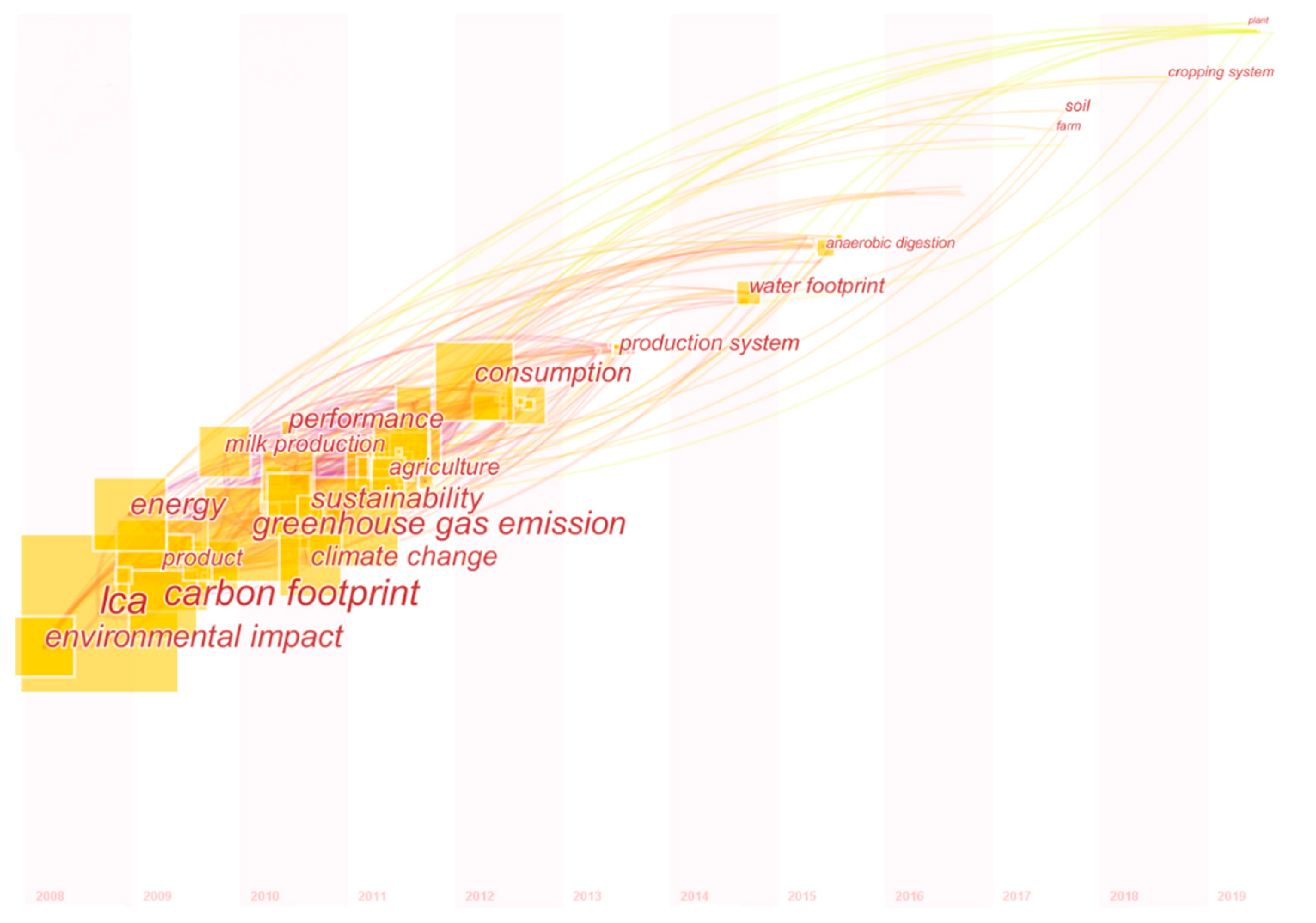This paper analysed the emerging trends of the focus topic from the document co-citation and keyword co-occurrence perspectives. First, we reorganized the document co-citation network in
Section 3 from the perspective of timeline to analyse the clusters and bursts of documents. Second, we established a keyword co-occurrence network based on the disciplines and terms network in
Section 3 from the perspective of time-zone to analyse the bursts and development trend of keywords.
4.1. References Analysis with Citation Bursts
Based on the above efforts, we obtained a document co-citation network from the timeline perspective as shown in
Figure 7. As can be seen from the distribution of major clusters along the time axis, beef production and dairy industry, as well as assessment method, are long-term topics in this kind of research. Topics of water footprint, aware method and grain system appeared in recent years.
From the reference bursts as shown in
Table 10 [
23,
24,
25,
26,
27,
28,
29,
30,
31,
32], the documents widely cited in recent years are S. Hellweg [
25] and D. Tilman [
29]. S. Hellweg [
25] reviewed and summarized the latest LCA methods, arguing that LCA methods could locate environmentally relevant hotspots in complex value chains, but at the expense of simplification and uncertainty. In the future, the LCA approach needs to be more practical and accurate, and its application in the assessment of economic and social aspects should be expanded. D. Tilman [
29] discussed the impact of changes in dietary trends on carbon emissions. More and more foods in the diet structure of modern people are refined sugar and fat. If not controlled, such diet structure will lead to a substantial increase in agricultural greenhouse gas emissions. Meanwhile, it will have a negative impact on health. Thus, the paper advocated a healthy alternative diet to solve the diet–environment–health trilemma.
4.2. Keyword Analysis with Citation Bursts
We set the time slicing in CiteSpace as one year per slice and extracted the top 50 cited keywords from each slice before pruning the sliced network in the pathfinder mode to obtain the keyword co-occurrence network; the network in the time-zones is as shown in
Figure 8. Most of the high-frequency keywords appeared in the early stages of research, such as the two keywords of this study, namely “LCA” and “carbon footprint”. In line with the analysis of noun terms, “environment impact” was the earliest high-frequency word and the origin and essence of the research in this field, i.e., how to adopt a proper LCA method in accordance with the carbon footprint concept to evaluate the environmental impact of an activity. In recent years, there were fewer new high-frequency keywords, some of which were “water footprint”, “anaerobic digestion” and “plant”. Their emergence indicates that the research in the field has become more extensive and in-depth. “Water footprint” is a horizontal extension of “carbon footprint”, which makes the measurement system more complete. “Plant” and “anaerobic digestion” is an upward and downward extension of the research respectively, with the former focusing on the important sources of carbon emissions and the later ways to improve the environment.
In addition, the keyword bursts can be analysed based on the citation frequency. As shown in
Table 11, “inventory”, “industrial ecology” and “sustainable development” became keywords during the period of document bursts in this field and have been keywords for a long time. In recent years, “crop”, “soil” and “China” have become the bursting keywords. “China” has emerged as a keyword mainly because of the rapid development of the Asian research collaboration network in recent years, which has shifted the research focus from Europe and America to Asia. “Crop” became a focus due to the concerns for feed production in farm carbon footprint measurement and for the carbon footprint of crop cultivation [
33,
34]. “Soil” attracted much attention due to the fact that, like atmosphere, soil is another final destination for carbon. For example, if the soil is of potential for organic carbon sequestration, it is possible that the net greenhouse gas emissions from pasture systems decrease drastically [
35].
As indicated by literature and the trend analysis above, the latest hot topics related to the focus topic involve several aspects—the combination of LCA and carbon footprint and its application, carbon footprint measurement of different products, and environmental impact and carbon footprint.
The combination of LCA and carbon footprint and its application. At present, there are still some limitations in the application of quantitative LCA methods to study the environmental impacts caused by resource utilization and waste discharge during product production. For example, social and economic factors are evaluated only via qualitative analysis, and time and space factors are not given sufficient attention [
36]. These limitations have not been resolved by the combination of LCA and carbon footprint. At present, some scholars try to do so through the dynamic LCA method [
37]. LCA is an approach that has been applied to the measurement of a carbon footprint since the proposal of this concept. In addition to the above limitations, this approach is more suitable for the measurement of specific products at the microscopic level, because it is still difficult to define the boundary at the macro level (such as the carbon footprint of organizations). For instance, it is hard to decide whether the carbon emissions of aircraft manufacturing should be included when calculating the flight carbon footprint. In contrast, the input–output method can offset the calculation errors caused by the complex division of labour, so some researchers have combined the two to develop the hybrid LCA method, which makes the boundary clearer to some extent [
38]. However, this method requires high-quality data and technology, so how to better apply LCA in the carbon footprint field will still be a hot topic related to the focus topic in the future.
Carbon footprint measurement for different products. Since LCA is more suitable for calculating carbon footprint at the product level, there is a large body of literature discussing different types of specific products, such as beef and milk which are classic measured products. Both of them are important sources of protein, and other sources of protein, such as fish and shrimp, are also the subject of carbon footprint measurement. Due to the differences in production systems, the environmental friendliness of different protein sources differs remarkably [
39]. Crops are another subject of carbon footprint measurement, such as wheat [
40], tomatoes [
41] and organic farming crops. All of the products mentioned above are related to diet and nutrition, so the adjustment of diet structure has an impact on carbon emissions, and the relationship between food carbon footprint, demographic characteristics and environment will gain more attention. As stated in the section of disciplinary analysis, this is an interdisciplinary field of Environmental Science and Ecology and Food Science and Technology, and a potential point of growth for those disciplines. In recent years, cities as an important source of carbon emissions have also received more and more attention from researchers. Specific research topics include the impact of urban green space projects on carbon emissions [
42], and the relationship between citizen behaviours and urban carbon emissions [
43]. The carbon footprint of citizen behaviours is primarily related to private driving, housing-related activities, and consumer behaviours. Private driving, which involves the interdisciplinary field of Environmental Science and Ecology and Energy and Fuels, has attracted much attention. With the emergence of electric vehicles [
44], it is likely to become one of the hot research directions. In terms of housing-related activities, a concerned aspect of the focus topic is how to use LCA to intervene in the early stages of building design to order to reduce carbon emissions of building construction [
45]; the comparison of carbon footprints between environmentally friendly homes and ordinary ones is also one of the hot topics [
46]. In addition, the measurement of the carbon footprint of consumer goods is also a concerned aspect of the focus topic, and changes in consumer demand can have an impact on carbon emissions [
47]. However, the application of the LCA approach has high requirements on data. The literature on the focus topic studies urban issues only at the micro level. With the application of big data and the advancement of LCA, the use of LCA to measure urban carbon footprint may be one of the future research directions.
Environmental impact and carbon footprint. Carbon footprint was proposed to measure the environmental impact of economic activities, so environmental impact has always been a hot word of the focus topic. Carbon footprint is an indicator or a concept. As a measurement indicator of greenhouse gas emissions, carbon footprint has already adopted the concept of carbon equivalent and taken carbon-free greenhouse gases into consideration. Nevertheless, it still cannot be the sole indicator of environmental impact. However, the concept of carbon footprint has contributed to alleviating the environmental burden. On the one hand, compared with obscure terms like Multi-Region Input–Output Model (MRIO) and LCA, carbon footprint is simple, easy to understand and interesting. The wide spreading and extensive application of this concept may have influenced people’s behaviours of environmental impact [
48]. On the one hand, the concept of carbon footprint provides new ideas for assessing other environmental impact factors and has inspired the proposal of water footprint, ecology footprint, energy footprint and even the family of footprints. A growing body of literature is attempting to use a more comprehensive evaluation system to measure the environmental impact of an economic activity based on the combination of LCA and carbon footprint.


